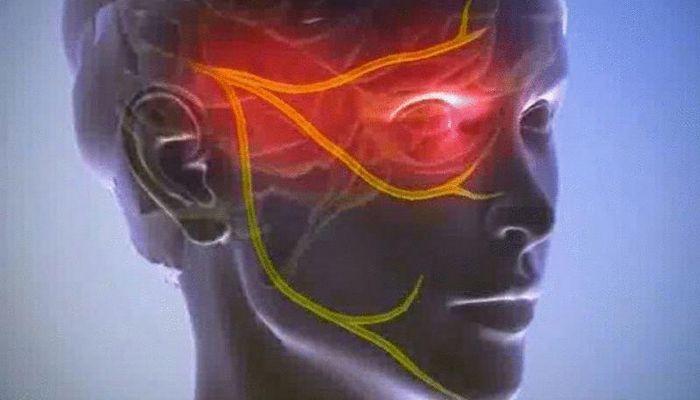Neuralgia - what is this disease, the cause of the? Description, symptoms of the disease and prevention of neuralgia

Neuralgia - the defeat of the peripheral nerve. The disease is characterized by the emergence of attacks of pain in the affected area of the nerve in the absence of motor or sensory disturbances dysfunction.
The cause of the
Neuralgia pain is a result of nerve irritation.
Trigeminal neuralgia is usually associated with compression (squeezing) nerve trunk inside or outside the skull. The most frequent causes of intercostal neuralgia are herpes zoster, thoracic spine osteochondrosis, back injury or subcooling. front, occipital neuralgia may develop as a result of cervical spine injuries, osteochondrosis, hypothermia in the neck, neck.
symptoms of neuralgia
Neuralgia patients worried about severe pain along the nerve innervation. The pain can be of different nature - dull, aching, acute, tingling, sometimes accompanied by a burning sensation or sweating. Usually, twinges arise suddenly, burdened vegetative-vascular disorders: erythema, lacrimation. Often there is a common tick, muscle cramps.
Trigeminal neuralgia begins, usually, with the appearance of acute pain in the face. Sometimes pain develops gradually - during the day marked short-term pain, going alone. Attack of neuralgia in the facial area is called trigeminal attack. Pain in trigeminal neuralgia is characterized by periods of remission and exacerbation of, is shooting in nature ('Attack during') and provoked, usually, touches to certain parts of the face (when chewing, during toothbrushing, washing). Pains appear in one half of the face. Painful attacks almost never occur at night. Trigeminal attack is sometimes accompanied by twitching of individual muscles, numbness of the skin on the affected side. Atypical trigeminal attack is characterized by a constant, exciting part of a more extensive facial pain. When such current may be periods of remission of pain.
Neuralgia glossopharyngeal nerve having pain in the base of the tongue, in the ear passage, throat. Attacks can occur at night.
Neuralgia occipital nerve pain comes back and front of the head, It can spread to the face area. For occipital neuralgia is characterized by burning, throbbing pain, sometimes turning into shooting, extended character.
Usually, the pain occurs at the base of the skull, It can be given in various departments of the head. In some patients, the pain occurs in the area of the eye on the affected side. The pain is usually unilateral. Contribute to the initiation of pain can be certain movements of the neck. In this case, the scalp is sensitive to the touch.
Intercostal neuralgia manifested paroxysmal or persistent pain along the intercostal nerves. The main symptom is the occurrence of seizures shooting pains in one intercostal space. Painful sensations are shingles character. Seizures are usually caused by change of body position, deep breath, turning torso, cough, but may appear spontaneously.
Neuralgia outer femoral cutaneous nerve firing is characterized by pain in the area of the outer surface of the femur. The pain is accompanied by paresthesias (benumbed sensation, polzaniya insect, acanthesthesia) on the outer surface of one or both hips. Twinges gradually become permanent. Pain amplified upright (especially at night) and walking. Besides, in the region of the outer surface of the femur defined by hyperesthesia (hypersensitivity) or hypoesthesia (reduced sensitivity).
Diagnostics
Diagnosis is based on the presence of characteristic complaints, neurological examination. In some cases (to exclude other pathology) used electroneurogram, computed tomography (CT), MRIs (MRT) spine, X-rays of the spine and thoracic organs, electrocardiography (ECG) and ultrasound (US), general clinical laboratory tests, a blood test for antibodies to herpes virus.
Classification
Neuralgia is divided into a primary (idiopaticescuu, eSSENTIAL, typical) and secondary (symptomatic).
The most common types of neuralgia:
- neuralgia nerve troynichnogo;
- facial and occipital neuralgia;
- mezhrebernaya neuralgia;
- neuralgia naruzhnogo kozhnogo nerve thighs.
Actions of the patient
In the event of neuralgia symptoms should consult a neurologist.
neuralgia treatment
Treatment can be conservative or surgical. Initial forms of neuralgia is usually amenable to drug therapy: Non-narcotic analgesics (paracetamol, Analgin, Ibuprofen, menovazin, Ketoprofen, antipirin, ihtiolovaya ointment for topical analgesic and anti-inflammatory effect), vitamin (B vitamins), in particular drug milgamma etc.. Applied procaine blockade corresponding branch (chlorpromazine solution + novocaine solution), Carbamazepine. Reorganize the mouth and nose (treatment of chronic tonsillitis, caries, sinusitis, etc.).
The ineffectiveness of conservative therapy are resorting to surgical methods (nevroekzerez, neurolysis, nevrotomyya, traktotomiya, nevrektomiya). If necessary, promptly eliminate the compression of nerves, expanding the narrowed osseous tunnels.
When secondary neuralgia treat the underlying disease.
shown physiotherapy: iontophoresis, diadynamic, ultrasound therapy, reflexology.
Complications
Long-term pain leads to malnutrition, restrict movements volume, Chronic of pain.
prevention neuralgia
Preventative measures are to provide a full intake of essential minerals, Physical Activity, timely treatment of infectious diseases.
